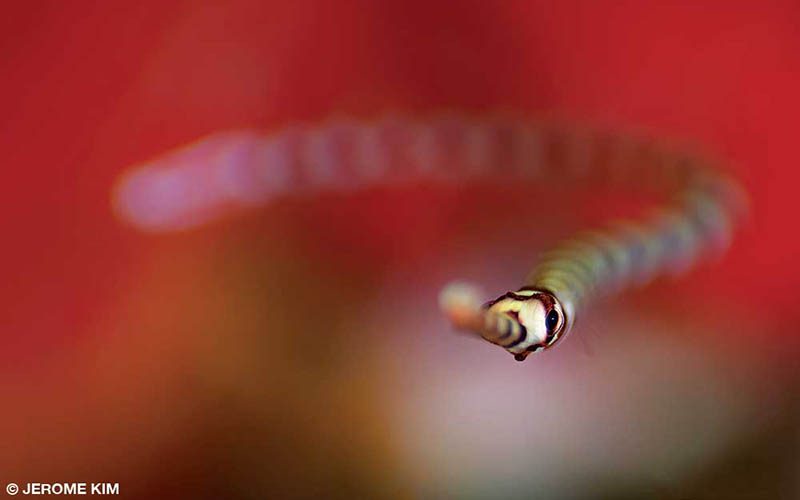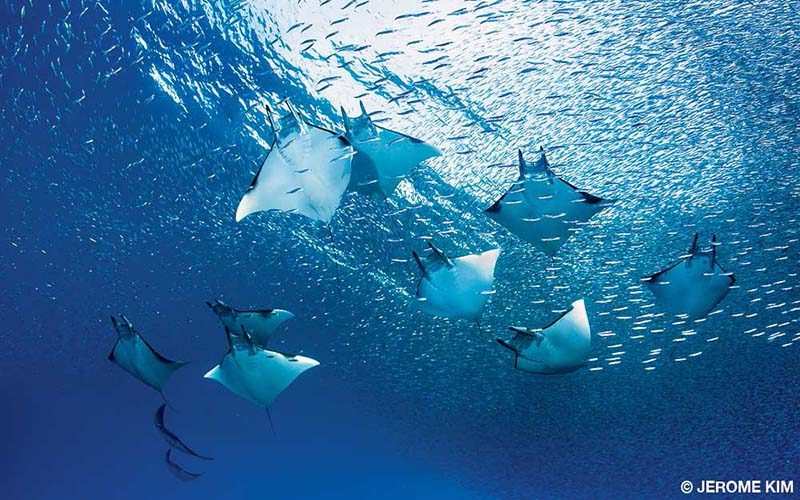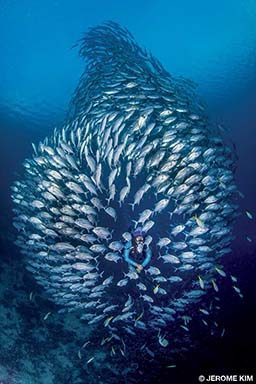The methods of image capture have certainly evolved over the years. I remember the first time I read about an underwater photographer who had never shot film; it was in an article about Eric Cheng, the founder of Wetpixel.com. That fact was illustrative of a sea change in photographic technology. Now, a dozen years later, it is likely that many of the marine photographers doing significant work today may have never experienced the frustration of having only 36 film exposures on any given dive. It’s probably safe to assume that photographers born in the mid-1980s or later have never shot film.
Where we see underwater photography has likewise changed. In the early days, we saw most images on the pages of books and magazines. Now, however, new, meaningful underwater photographs can regularly dazzle us on social media. It is through social media that I first came across the work of Jerome Kim.

Using an extremely shallow depth of field is an effective way to create a pleasant bokeh in the background. You can focus on some important spot (in this case, the eye of the pipefish) and make the other parts a background of complementary but not conflicting elements.
What struck me most about Kim’s work is his unique style. He is not a “spray and pray” shooter — someone who takes hundreds of images in the hope that one will be good. His images are far more considered and often demonstrate a high degree of technical expertise.

Inhabitants of the Misool region of Raja Ampat, Indonesia, these mobula rays and silversides are among the area’s most famous attractions. When shooting large schools of fish, I often prefer relying on available light rather than using a strobe. In this case I added just a touch of strobe to make the photo more dramatic and to more clearly separate the rays from the silversides.
Soon after I discovered his work, I found out, to my great surprise, that Kim is not a full-time professional photographer. He is an architect with a consuming passion for underwater photography. Perhaps his professional background has helped to define his signature aesthetic.
Unlike so many North American shooters, Jerome Kim didn’t spend his childhood enthralled by Sea Hunt or Jacques Yves-Cousteau’s television specials. He grew up in Pusan, South Korea, and his mother was from Geoje Island, where he visited during family vacations. The waters surrounding Geoje Island, the second largest island off the South Korean coast, are quite cold, but they are where Kim’s fascination with the sea began.

You need to plan and communicate well with your model before shooting, and it helps to have the image in mind before you and your model work together on the composition. The vertical aspect of this school of jacks came to my mind, and I directed my model to circle behind and swim through the school. As the jacks parted for her, they made the loveliest arrangement for me.
Kim soon found himself in warmer waters; his parents’ work involved travel to the Philippines, which provided opportunities to dive in Anilao. He began diving there in 1991, even though he did not become a certified scuba diver until 1996. The location so enraptured him that he took his wife diving there on their honeymoon. He even opened his architecture firm there in 2000, landing some big Korean government projects in the area, including the Korean embassy building and the PEFTOK Korean War Memorial Hall in Manila.
By 2005 photography had become a serious avocation for Kim. At the time he had a small point-and-shoot compact camera for souvenir photos and even, for a short while, a Nikonos film camera. His induction into serious digital photography began while diving in Puerto Galera one week; there he met a diver from Hong Kong who was shooting with a housed digital single-lens reflex (DSLR) camera. The diver’s results were so far superior to his own that he traveled to Hong Kong the very next week to buy a similar system. He began with a Canon EOS 400D in a Sea and Sea housing and has been shooting Canon ever since, working his way up the ladder to a 5D Mark II, 5D Mark III, 5DS R and now a 5D Mark IV, always using Sea and Sea housings.

More than simply focusing on subjects, my primary interest in underwater photography is making better backgrounds. Shallow depth of field can create soft and colorful backgrounds while at the same time allow the eye to go directly to the main subject. The distance between the foreground subject and the background can also make a difference. For this image, the aperture was relatively small, but the distant background provided the level of blur I hoped to achieve.
For the next five years Kim went to Anilao almost every weekend. It is only a two-hour drive from Manila, and the diving is reliably spectacular. Despite having no formal training in underwater photography, he has been served well in his photography by the discipline and artistry that drew him to architecture, allowing him to progress quickly. He’s won more than 60 awards in international photography competitions and has been featured on DivePhotoGuide.com, Scubanet.kr and Underwaterphotography.com and in Sea and Sea magazine, the Washington Post, the Philadelphia Inquirer and the Manila Bulletin. He has also served on the United Nations judging panel for the World Oceans Day photo competition and has conducted on-location underwater photo seminars for the tourism departments of both Okinawa and Taiwan. Beyond that, his collaboration with the Philippines Department of Tourism led to the creation a few years ago of the Anilao Underwater Shootout photo competition, which is becoming the most widely attended event of its kind in all of Asia.
Through it all, the driving force behind Kim’s passion for underwater photography is his love of travel with friends and his personal drive to create better and better images, whatever the subject.
Much of his emphasis is on macro photography, as it is a discipline he understands and enjoys, but he is equally adept at fish portraiture and wide-angle photos. His modus operandi is to provide something fresh. “I’m trying to shoot in a way that is clearly different from what others might be doing,” he said. “I want my images to tell a story at a glance, and I can do that through composition or selective focus and targeted lighting.”
While many photographers in Asia play with new color techniques and other types of manipulation, Kim prefers to push the limits of his camera’s capture abilities. “Sometimes I’ll spend more than two hours on a single subject, meditating on lighting and focus,” Kim explained. “I’m always thinking about depth of field and how to draw the eye to some point of particular interest.”
When asked about his future in underwater photography, Kim said he plans to build a version 2.0 of himself who won’t work quite so hard in architecture and will find some way to bring together his love of diving and underwater photography for vocation as well as avocation. Maybe he’ll build a dive resort catering to underwater photographers. He could draw up the plans, oversee the construction and then take us all diving. I have no doubt it would be in a place of spectacular beauty, both topside and underwater. Sign me up, Jerome Kim.

These unique gobies are found in the Western Pacific. You need to approach very carefully when shooting shy subjects. Moving too quickly can create a pressure wave that scares the fish. Bad buoyancy can stir sediment off the bottom and create backscatter. Good diving skills are very important, not only for getting near the fish but also for not affecting the environment.

When your subjects show different attitudes than normal, it is wise to observe further. This yellow goby seemed unusually reluctant to leave this sponge as I swam by, and only on closer inspection did I see the eggs she was guarding. The maternal instinct is very strong in almost all animals, even this tiny fish.
| © Alert Diver — Q4 2018 |